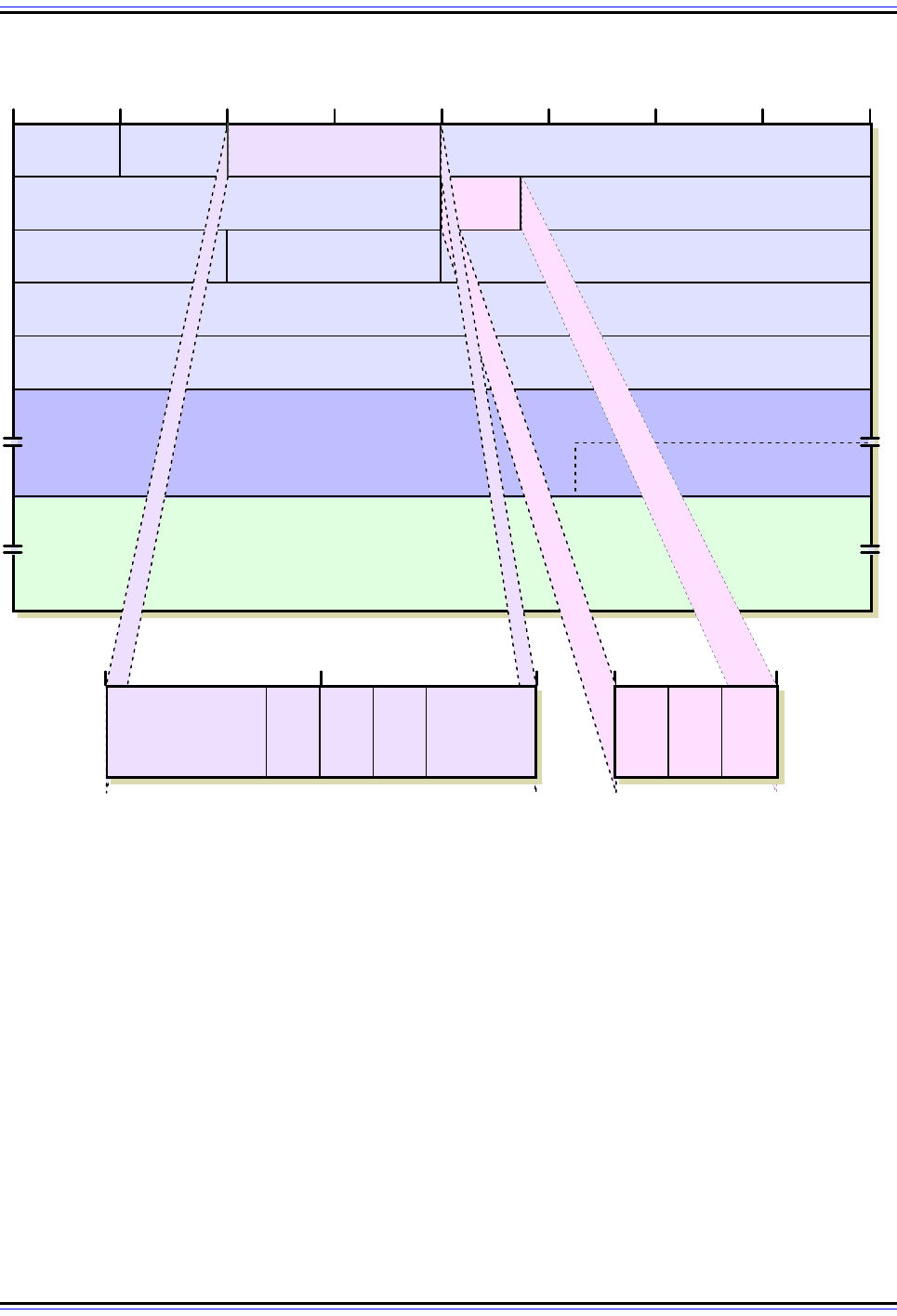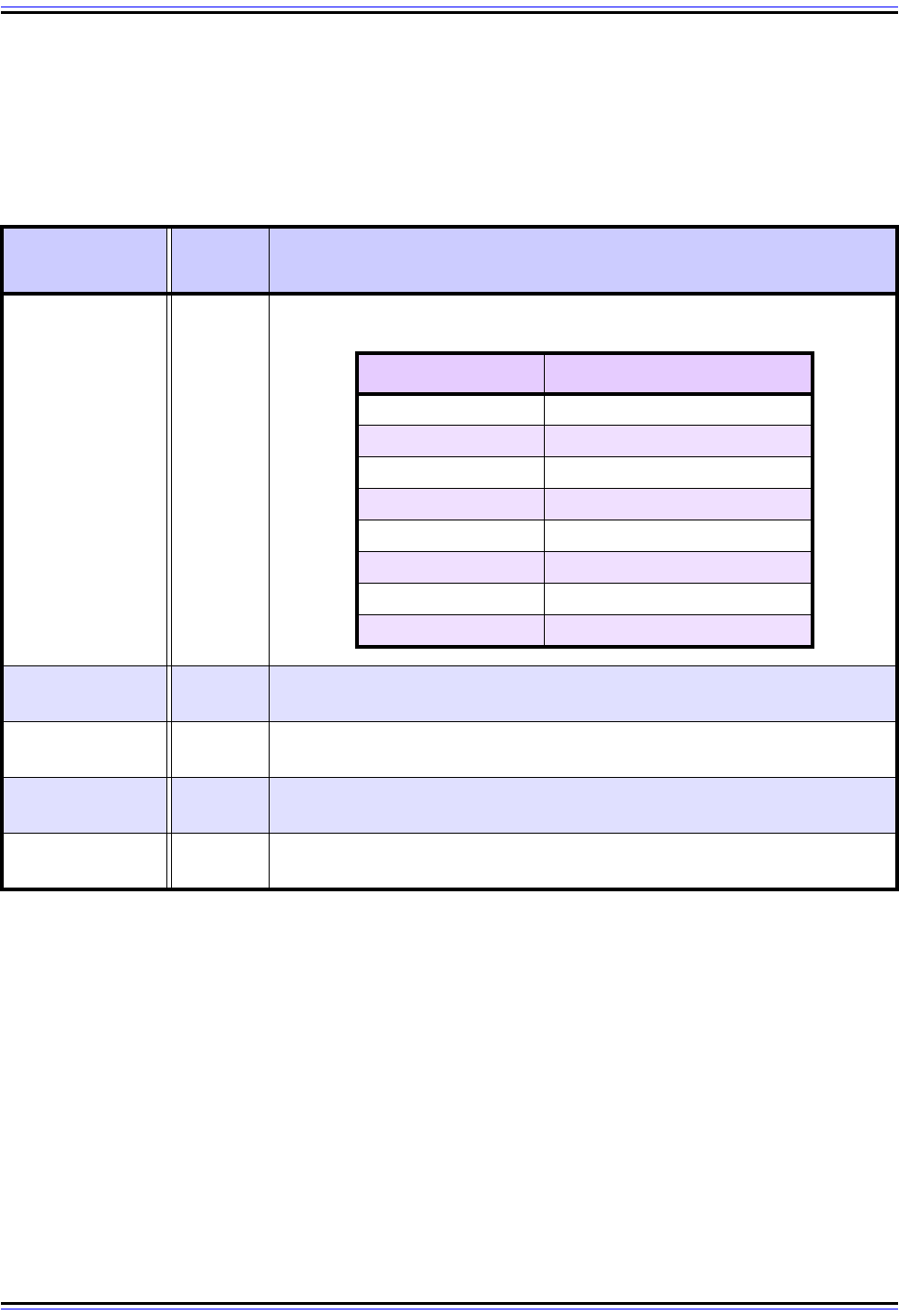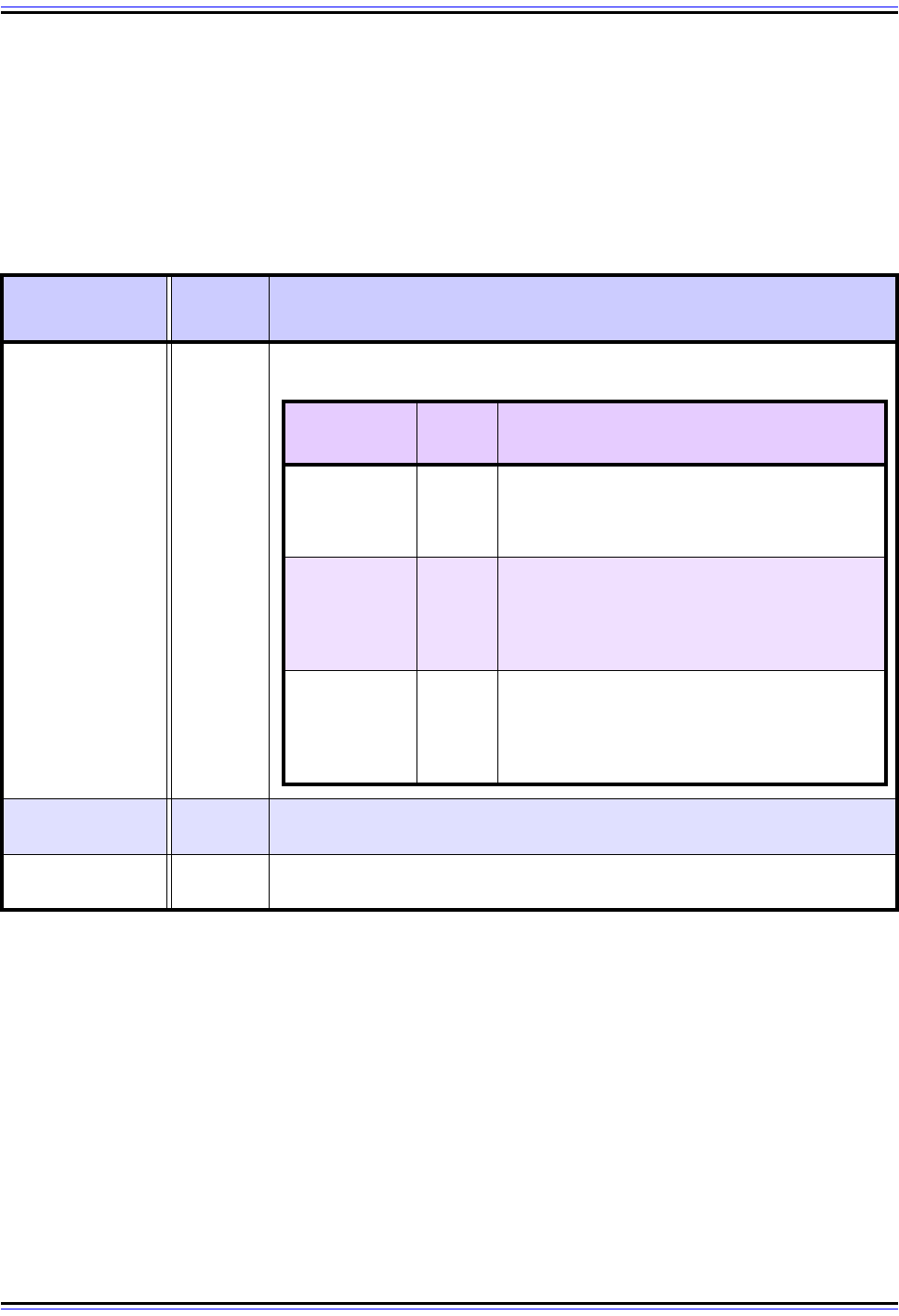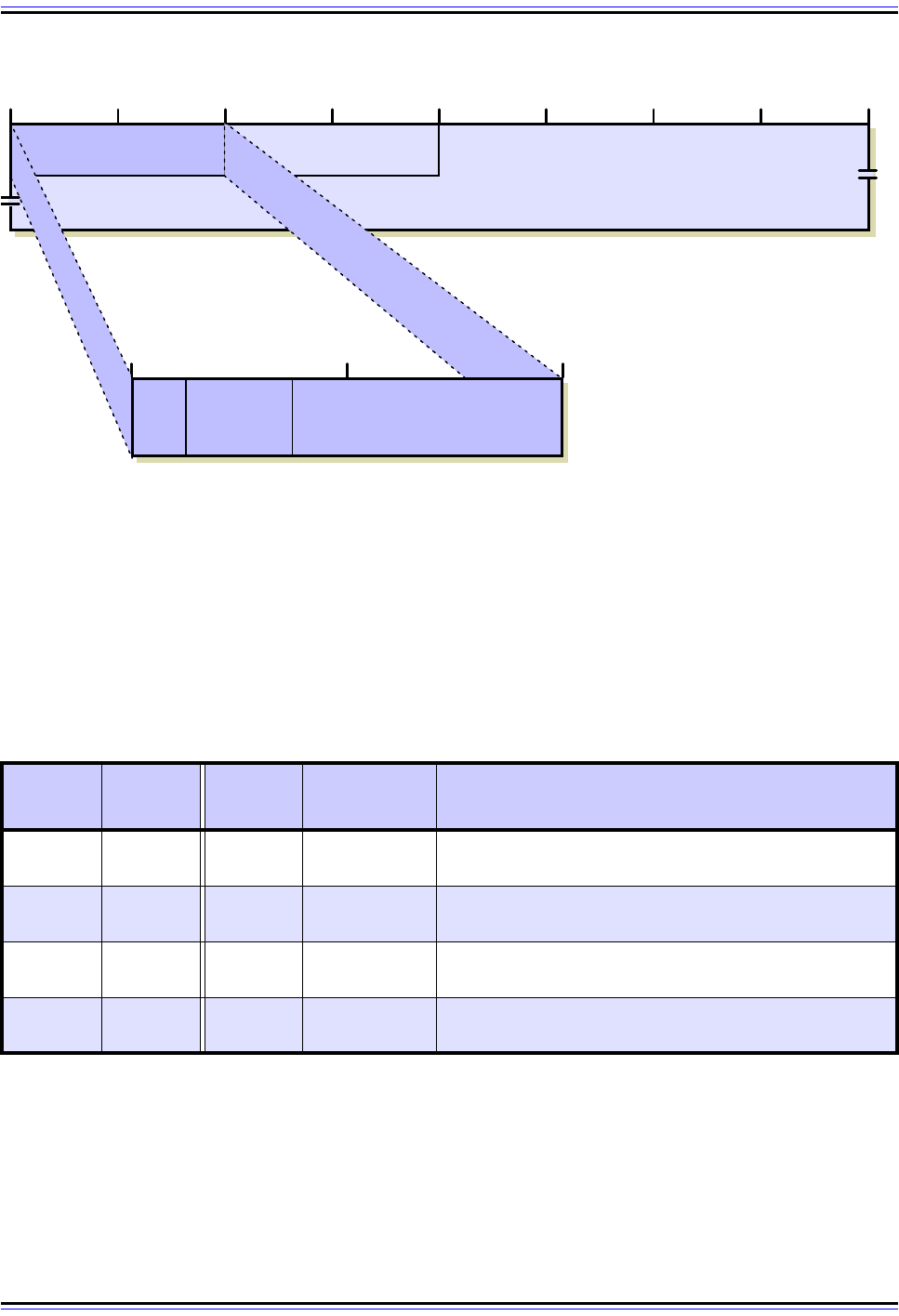Charles M. Kozierok The TCP-IP Guide
Подождите немного. Документ загружается.


The TCP/IP Guide - Version 3.0 (Contents) ` 421 _ © 2001-2005 Charles M. Kozierok. All Rights Reserved.
Fragment Offset
1 5/8
(13 bits)
Fragment Offset: When fragmentation of a message occurs, this field
specifies the offset, or position, in the overall message where the data in
this fragment goes. It is specified in units of 8 bytes (64 bits). The first
fragment has an offset of 0. Again, see the discussion of fragmentation for
a description of how the field is used.
TTL 1
Time To Live (TTL): Short version: Specifies how long the datagram is
allowed to “live” on the network, in terms of router hops. Each router decre-
ments the value of the TTL field (reduces it by one) prior to transmitting it. If
the TTL field drops to zero, the datagram is assumed to have taken too
long a route and is discarded.
See below for the longer explanation of TTL.
Protocol 1
Header
Checksum
2
Header Checksum: A checksum computed over the header to provide
basic protection against corruption in transmission. This is not the more
complex CRC code typically used by data link layer technologies such as
Ethernet; it's just a 16-bit checksum. It is calculated by dividing the header
bytes into words (a word is two bytes) and then adding them together. The
data is not checksummed, only the header. At each hop the device
receiving the datagram does the same checksum calculation and on a
mismatch, discards the datagram as damaged.
Table 57: Internet Protocol Version 4 (IPv4) Datagram Format (Page 2 of 3)
Field Name
Size
(bytes)
Description
P
ro
t
oco
l
:
Id
en
tifi
es
th
e
hi
g
h
er-
l
ayer pro
t
oco
l
(
genera
ll
y e
ith
er a
t
ranspor
t
layer protocol or encapsulated network layer protocol) carried in the
datagram. The values of this field were originally defined by the IETF
“Assigned Numbers” standard, RFC 1700, and are now maintained by the
Internet Assigned Numbers Authority (IANA):
Note that the last two entries are used when IPSec inserts additional
headers into the datagram: the AH or ESP headers.
Value
(Hexadecimal)
Value
(Decimal)
Protocol
00 0 Reserved
01 1 ICMP
02 2 IGMP
03 3 GGP
04 4 IP-in-IP Encapsulation
06 6 TCP
08 8 EGP
11 17 UDP
32 50
Encapsulating Security Payload (ESP)
Extension Header
33 51
Authentication Header (AH)
Extension Header

The TCP/IP Guide - Version 3.0 (Contents) ` 422 _ © 2001-2005 Charles M. Kozierok. All Rights Reserved.
That’s a pretty big table, because the IP datagram format is pretty important and has a lot of
fields that need explaining. To keep it from being even longer, I decided to move a couple of
the more complex descriptions out of the table.
Time To Live (TTL) Field
Since IP datagrams are sent from router to router as they travel across an internetwork, it is
possible that a situation could result where a datagram gets passed from router A to router
B to router C and then back to router A. Router loops are not supposed to happen, and
rarely do, but are possible.
To ensure that datagrams don't circle around endlessly, the TTL field was intended to be
filled in with a time value (in seconds) when a datagram was originally sent. Routers would
decrease the time value periodically, and if it ever hit zero, the datagram would be
destroyed. This was also intended to be used to ensure that time-critical datagrams
wouldn’t linger past the point where they would be “stale”.
In practice, this field is not used in exactly this manner. Routers today are fast and usually
take far less than a second to forward a datagram; measuring the time that a datagram
“lives” would be impractical. Instead, this field is used as a “maximum hop count” for the
datagram. Each time a router processes a datagram, it reduces the value of the TTL field by
one. If doing this results in the field being zero, the datagram is said to have expired. It is
dropped, and usually an ICMP Time Exceeded message is sent to inform the originator of
the message that this happened.
Source Address 4
Source Address: The 32-bit IP address of the originator of the datagram.
Note that even though intermediate devices such as routers may handle
the datagram, they do not normally put their address into this field—it is
always the device that originally sent the datagram.
Destination
Address
4
Destination Address: The 32-bit IP address of the intended recipient of
the datagram. Again, even though devices such as routers may be the
intermediate targets of the datagram, this field is always for the ultimate
destination.
Options Variable
Options: One or more of several types of options may be included after
the standard headers in certain IP datagrams. I discuss them in the topic
that follows this one.
Padding Variable
Padding: If one or more options are included, and the number of bits used
for them is not a multiple of 32, enough zero bits are added to “pad out” the
header to a multiple of 32 bits (4 bytes).
Data Variable
Data: The data to be transmitted in the datagram, either an entire higher-
layer message or a fragment of one.
Table 57: Internet Protocol Version 4 (IPv4) Datagram Format (Page 3 of 3)
Field Name
Size
(bytes)
Description

The TCP/IP Guide - Version 3.0 (Contents) ` 423 _ © 2001-2005 Charles M. Kozierok. All Rights Reserved.
The TTL field is one of the primary mechanisms by which networks are protected from
router loops (see the description of ICMP Time Exceeded messages for more on how TTL
helps IP handle router loops.)
Type Of Service (TOS) Field
This one-byte field was originally intended to provide certain quality of service features for
IP datagram delivery. It allowed IP datagrams to be tagged with information indicating not
only their precedence, but the preferred manner in which they should be delivered. It was
divided into a number of subfields, as shown in Table 58 (and Figure 86).
Figure 86: Internet Protocol Version 4 (IPv4) Datagram Format
This diagram shows graphically the all-important IPv4 datagram format. The first 20 bytes are the fixed IP
header, followed by an optional Options section, and a variable-length Data area. Note that the Type Of
Service field is shown as originally defined in the IPv4 standard.
Version
Internet Header
Length (IHL)
Type Of Service (TOS) Total Length (TL)
Flags Fragment Offset
Protocol Header Checksum
Data
4 8 12 16 20 24 28 320
Padding
480 30
Re-
served
Don't
Frag-
ment
(DF)
Mor e
Frag-
ments
(MF)
Precedence
Delay
Throu-
ghput
Reli-
ability
Reserved
Options
Destination Address
Source Address
Time To Live (TTL)
Identification

The TCP/IP Guide - Version 3.0 (Contents) ` 424 _ © 2001-2005 Charles M. Kozierok. All Rights Reserved.
The lack of quality of service features has been considered a weakness of IP for a long
time. But as we can see in Table 58, these features were built into IP from the start. What's
going on here? The answer is that even though this field was defined in the standard back
in the early 1980s, it was not widely used by hardware and software. For years, it was just
passed around with all zeroes in the bits and mostly ignored.
The IETF, seeing the field unused, attempted to revive its use. In 1998, RFC 2474 redefines
the first six bits of the TOS field to support a technique called Differentiated Services (DS).
Under DS, the values in the TOS field are called codepoints and are associated with
different service levels. This starts to get rather complicated, so refer to RFC 2474 if you
want all the details.
Understanding the IP datagram format is an important part of troubleshooting IP networks.
Be sure to see the following topic on options for more information on how IP options are
used in datagrams, and the topic on fragmenting for some more context on the use of
fragmentation-related fields such as Identification, Fragment Offset, and More Fragments.
Table 58: Original Definition Of IPv4 Type Of Service (TOS) Field
Subfield Name
Size
(bytes)
Description
Precedence
3/8
(3 bits)
D
1/8
(1 bit)
Delay: Set to 0 to request “normal” delay in delivery; set to 1 if low delay
delivery is requested.
T
1/8
(1 bit)
Throughput: Set to 0 to request “normal” delivery throughput; set to 1 if
higher throughput delivery is requested.
R
1/8
(1 bit)
Reliability: Set to 0 to request “normal” reliability in delivery; set to 1 if
higher reliability delivery is requested.
Reserved
2/8
(2 bits)
Reserved: Not used.
P
rece
d
ence:
A
fi
e
ld
i
n
di
ca
ti
ng
th
e pr
i
or
it
y o
f
th
e
d
a
t
agram.
Th
ere were
eight defined values, from lowest to highest priority:
Precedence Value Priority Level
000 Routine
001 Priority
010 Immediate
011 Flash
100 Flash Override
101 CRITIC/ECP
110 Internetwork Control
111 Network Control

The TCP/IP Guide - Version 3.0 (Contents) ` 425 _ © 2001-2005 Charles M. Kozierok. All Rights Reserved.
IP Datagram Options and Option Format
All IP datagrams must include the standard 20-byte header, which contains key information
such as the source and destination address of the datagram, fragmentation control param-
eters, length information and more. In addition to these invariable fields, the creators of
IPv4 included the ability to add options that provide additional flexibility in how IP handles
datagrams. Use of these options is, of course, optional. ☺ However, all devices that handle
IP datagrams must be capable of properly reading and handling them.
The IP datagram may contain zero, one or more options, which makes the total length of
the Options field in the IP header variable. Each of the options can be either a single byte
long, or multiple bytes in length, depending on how much information the option needs to
convey. When more than one option is included they are just concatenated together and put
into the Options field as a whole. Since the IP header must be a multiple of 32 bits, a
Padding field is included if the number of bits in all options together is not a multiple of 32
bits.

The TCP/IP Guide - Version 3.0 (Contents) ` 426 _ © 2001-2005 Charles M. Kozierok. All Rights Reserved.
IP Option Format
Each IP option has its own subfield format, generally structured as shown in Table 59 and
Figure 87. For most options, all three subfields are used: Option Type, Option Length and
Option Data. For a few simple options, however, this complex substructure is not needed. In
those cases, the option type itself communicates all the information required, so the Option
Type field appears alone, while the Option Length and Option Data subfields are omitted.
Table 59: Internet Protocol Version 4 (IPv4) Option Format
Subfield Name
Size
(bytes)
Description
Option Type 1
Option Length 0 or 1
Option Length: For variable-length options, indicates the size of the entire
option, including all three subfields shown here, in bytes.
Option Data
0 or
Variable
Option Data: For variable-length options, contains data to be sent as part
of the option.
O
p
ti
on
T
ype:
Thi
s
8
-
bit
fi
e
ld
i
s
di
v
id
e
d
i
n
t
o
th
ree
“
su
b
-su
bfi
e
ld
s
”
, accor
di
ng
to the following format:
Sub-Subfield
Name
Size
(bytes)
Description
Copied
1/8
1 bit)
Copied Flag: This bit is set to 1 if the option is
intended to be copied into all fragments when a
datagram is fragmented; it is cleared to 0 if the
option should not be copied into fragments.
Option Class
2/8
(2 bits)
Option Class: Specifies one of four potential
values that indicate the general category into
which the option belongs. In fact, only two of the
values are used: 0 is for Control options, and 2 for
Debugging and Measurement.
Option
Number
5/8
(5 bits)
Option Number: Specifies the kind of option. 32
different values can be specified for each of the
two option classes. Of these, a few are more
commonly employed. See below for more infor-
mation on the specific options.

The TCP/IP Guide - Version 3.0 (Contents) ` 427 _ © 2001-2005 Charles M. Kozierok. All Rights Reserved.
IP Options
Table 60 lists the most common IPv4 options, showing the option class, option number and
length for each (a length of 1 indicating an option that consists of only an Option Type field),
and providing a brief description of how each is used.
Figure 87: Internet Protocol Version 4 (IPv4) Option Format
This diagram shows the full field format for an IPv4 option. Note that a few simple options may consist of only
the Option Type subfield, with the Option Length and Option Data subfields omitted.
Table 60: Internet Protocol Version 4 (IPv4) Options (Page 1 of 2)
Option
Class
Option
Number
Length
(bytes)
Option
Name
Description
001
End Of
Options List
An option containing just a single zero byte, used to
mark the end of a list of options.
0 1 1 No Operation
A “dummy option” used as “internal padding” to align
certain options on a 32-bit boundary when required.
0211 Security
An option provided for the military to indicate the
security classification of IP datagrams.
0 3 Variable
Loose Source
Route
One of two options for source routing of IP datagrams.
See below for an explanation.
4 8 12 16 20 24 28 320
Option Type
480
Option Length
Option Data
Cop-
ied
Option
Class
Option Number

The TCP/IP Guide - Version 3.0 (Contents) ` 428 _ © 2001-2005 Charles M. Kozierok. All Rights Reserved.
Key Concept: Each IPv4 datagram has a 20-byte mandatory header, and may also
include one or more options. Each option has its own field format, and most are
variable in size.
IP Options and Source Routing
Normally, IP datagrams are routed without any specific instructions from devices regarding
the path a datagram should take from the source to the destination. It's the job of routers,
using routing protocols, to figure out those details. In some cases, however, it may be
advantageous to have the source of a datagram specify the route a datagram takes through
the network. This is called source routing.
There are two IP options that support source routing. In each, the option includes a list of IP
addresses specifying the routers that must be used, to reach the destination. When strict
source routing is used, this means that the path specified in the option must be used
07Variable Record Route
This option allows the route used by a datagram to be
recorded within the header for the datagram itself. If a
source device sends a datagram with this option in it,
each router that “handles” the datagram adds its IP
address to this option. The recipient can then extract
the list of IP addresses to see the route taken by the
datagram.
Note that the length of this option is set by the origi-
nating device. It cannot be enlarged as the datagram
is routed, and if it “fills up” before it arrives at its desti-
nation, only a partial route will be recorded.
0 9 Variable
Strict Source
Route
One of two options for source routing of IP datagrams.
See below for an explanation.
24Variable Timestamp
This option is similar to the Record Route option.
However, instead of each device that handles the
datagram inserting its IP address into the option, it
puts in a timestamp, so the recipient can see how long
it took for the datagram to travel between routers.
As with the Record Route option, the length of this
option is set by the originating device and cannot be
enlarged by intermediate devices.
2 18 12 Traceroute
Used in the enhanced implementation of the
traceroute utility, as described in RFC 1393. Also see
the topic on the ICMP Traceroute messages.
Table 60: Internet Protocol Version 4 (IPv4) Options (Page 2 of 2)
Option
Class
Option
Number
Length
(bytes)
Option
Name
Description

The TCP/IP Guide - Version 3.0 (Contents) ` 429 _ © 2001-2005 Charles M. Kozierok. All Rights Reserved.
exactly, in sequence, with no other routers permitted to handle the datagram at all. In
contrast, loose source routing specifies a list of IP addresses that must be followed in
sequence, but having intervening hops in between the devices on the list is allowed.
For full details on the exact structure used by each option type, please refer to RFC 791.

The TCP/IP Guide - Version 3.0 (Contents) ` 430 _ © 2001-2005 Charles M. Kozierok. All Rights Reserved.
IP Datagram Size, Maximum Transmission Unit (MTU), Fragmentation
and Reassembly
IP's main responsibility is to deliver data between internetworked devices. As we saw in the
preceding section, this requires that data received from higher layers be encapsulated into
IP datagrams for transmission. These datagrams are then passed down to the data link
layer where they are sent over physical network links.
In order for this to work properly, each datagram must be small enough to fit within the
frame format of the underlying technology. If the message is bigger than the maximum
frame size of the underlying network, it may be necessary to break up an IP message into
several datagrams, a process called fragmentation. The datagrams are then sent individ-
ually and reassembled into the original message.
The Internet Protocol is designed to manage datagram size, and to allow fragmentation and
reassembly in a seamless manner. In this section I explore issues related to managing the
size of IP datagrams. I start with an overview of datagram size issues and the important
concept of a network's maximum transmission unit (MTU), discussing why fragmentation is
necessary. I then describe the process by which IP messages to be transmitted are
fragmented by the source device and possibly routers along the path to the destination, and
then outline how they are reassembled by the recipient.
Background Information: Explaining fragmentation and reassembly requires
some understanding of the basic format of IP datagrams and some of the fields
they contain. If you haven't yet read the topic describing IP datagram general
format you may wish to review it before proceeding here.
IP Datagram Size, the Maximum Transmission Unit (MTU), and Fragmentation
Overview
As the core network layer protocol of the TCP/IP protocol suite, IP is designed to implement
potentially large internetworks of devices. When we work with IP we get used to the concept
of hosts being able to send information back and forth even though they may be quite far
away and the data may need to travel across many devices between them. Even though we
can usually consider the TCP/IP internet to be like a large, abstract “virtual network” of
devices, we must always remember that underneath the network layer, data always travels
across one or more physical networks. The implementation of the Internet Protocol must
take this reality into account as well.
In order to send messages using IP we encapsulate the higher-layer data into IP
datagrams. These datagrams must then be sent down to the data link layer, where they are
further encapsulated into the frames of whatever technology is going to be used to physi-
cally convey them, either directly to their destination, or indirectly to the next intermediate
step in their journey to their intended recipient. The data link layer implementation puts the
entire IP datagram into the data portion (the payload) of its frame format, just as IP puts
